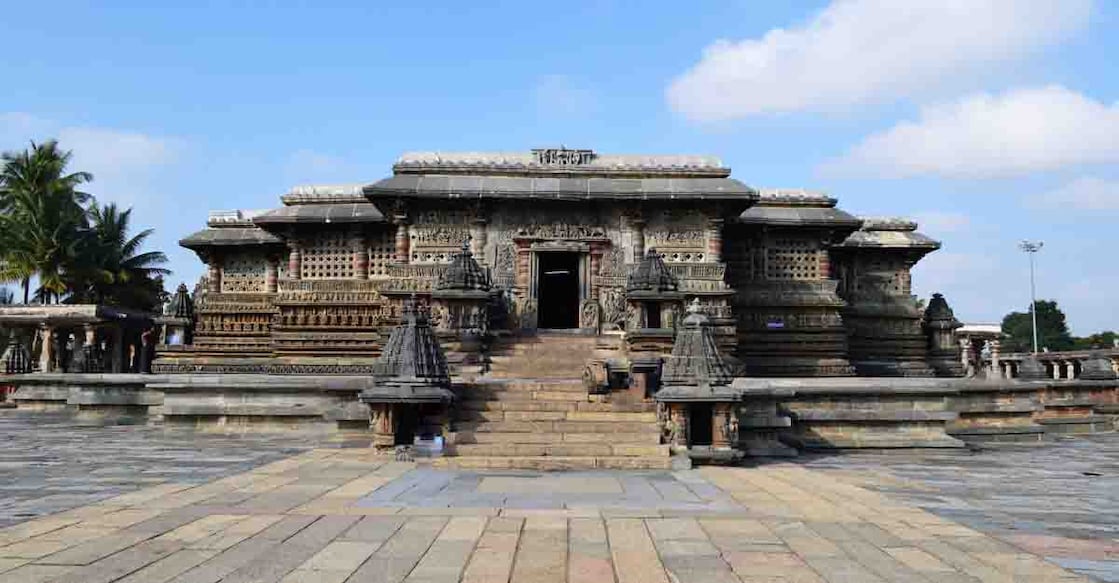Belur-Halebidu welcomes visitors with 'world's jewellery box in stone'

Mail This Article
The intricate sculptures at the Belur and Halebidu temples in Karnataka's Hassan district are awe-inspiring. Termed 'poetry in stone,' the temples were built by the Hoysala kings who ruled the area till the fourteenth century.
There is an interesting legend behind how the Hoysala dynasty was founded. In ancient times, youngsters were imparted education at 'gurukuls' (schools) deep inside the forest. The students lived with their teacher to gain knowledge. Once, a tiger attacked the teacher at a gurukul. All the students, except one boy, scattered in fright. The guru told the brave boy who remained at the spot, "Hoy. sala." The Kannada words translate to "Kill the tiger, my boy." The boy obeyed the teacher's command and later founded the Hoysala dynasty.
The Hoysala dynasty built 92 temples in various parts of Karnataka, of which only three remain and the shrines at Belur and Halebidu have survived the ravages of time.
Amazing stonework
Arriving at the Chennakeshava Temple at Belur, any weary traveller would feel refreshed seeing the architectural marvel. 'Chenna' is the Kannada word for beauty and the name of the temple refers to the deity, Keshava (Krishna). However, a visitor would feel that the temple itself is the most beautiful part of Belur.

Sculptors have not left even small corners to display their skill at the temple, which is designed in the shape of a three-layered lotus. While the innermost portion is the sanctum sanctorum, a 'Navaranga Mandapam' and the walls constitute the outer layers. The attraction of the walls is the presence of 39 stunning sculptures of 'salabhanjikas' (women) which support the roof.
A visitor stepping into the temple after enjoying the art on the outer walls would notice the figures of Santhala Devi, the queen and that of a dancer on either side of a pillar in front of the sanctum sanctorum.
Straight above, on the roof, is depicted the goddess Bhuvaneswari.
However, the goddess is seen not as a beautiful woman but as the central portion of the roof, which is round in shape. It is believed that Bhuvaneswari represents the trinity of gods.
In fact, most of the sculptures and statues at Belur are symbolic. For instance, in the area before inner precincts, the divine couple Rathi and Manmadha are seen separated. This suggests that all worldly desires have to be kept outside before entering the most sacred area of the shrine.
Jewellery box
It is estimated that over one thousand sculptures of women are present in Belur temple and each of them wear different jewellery. A foreign traveller, stunned by the jewellery work, had called the temple the 'world's jewellery box.'
Another unique feature of the shrine is a floor in the shape of a star. At some spots, imaginary creatures with body parts of different animals can be seen. A sculpture showing the emblem of the Hoysala kings, a boy fighting a tiger, is also present while a study conducted at the temple had counted 640 elephant figures.
Beyond all this finely-chiselled artwork, a visitor would find a granite pillar free of carvings. Made of a single stone, the lower part of the pillar does not touch the ground – a handkerchief would easily pass under it.

Halebidu
The temple complex of Halebidu is 15 km from Belur. The Kannada word Halebidu translates as 'Old capital' and the deity at the shrine is Lord Shiva. There are numerous eye-catching sculptures at Halebidu also and the sixth biggest Nandi sculpture in India is among them. The Santhaleswara-Hoysaleswara temples, 1,248 elephant sculptures on the base of the shrine, animals like lion and episodes from mythology carved on the walls are other attractions.
Accommodation
Hotel Mayura, a government guest house, is close to the Chennakeshava Temple, Belur. Contact number: 08177222209.
Things to note
Two-wheelers are banned in the Nagerhole forest. Travellers should not stop their vehicle or get down for any purpose in the woods. This is because the wild elephants in the area are known be aggressive. Total silence too has to be maintained.
Ensure the services of a guide at Belur as each sculpture would be associated with a legend.
Route by road
Ernakulam – Thrissur – Mananthavady – Kutta – Nagerhole – Hassan – Belur is a 505-km journey.
A three-day trip
A sojourn to Belur-Halebidu would involve a three-day trip from Ernakulam. By car, the ideal route would be through Nagerhole but take the Thirumathi forest route during the return trip as there is no ban on night travel here.
Starting from Ernakulam during the early hours, you can reach Manathavady by noon. After carrying out a safari along the Tholpetty road in the afternoon, rest for the night at Mananthavady.
Next morning, travel through the Nagerhole forest to Hassan. The sights of both Belur and Halebidu can be enjoyed during one full day. At night, rest at Hotel Mayura before driving back to Kerala in the morning.
Train travellers can head to Mangaluru, from where buses are available to Belur via Dharmasthala. Trains also ply from Mangaluru to Hassan Junction.

